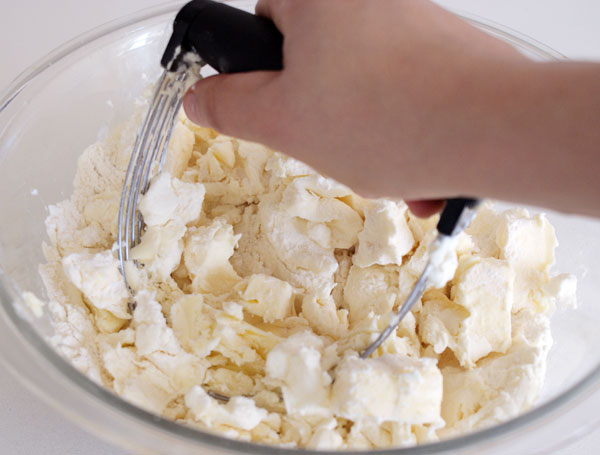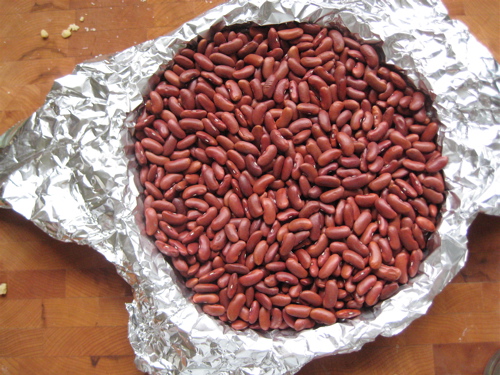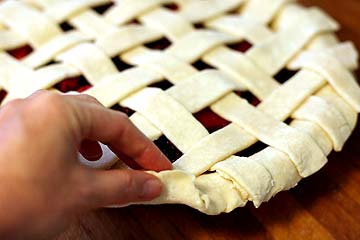The rich flavor of butter and the flake-making quality of vegetable shortening produce a pie pastry that is both versatile and delicious. The butter and shortening should be very cold so that they will form the layers in the crust that contribute to the overall flakiness. Use ice water for the liquid to ensure that the shortening and butter do not soften during mixing. If you are making a savory pie, such as a quiche or savory galette, omit the sugar.
To use up your dough scraps, press them together and roll them out again into a long, narrow rectangle. Brush the surface with softened butter and sprinkle it with cinnamon sugar. Working from a long side, roll up the rectangle into a log, then cut crosswise into sliced 1 inch thick. Place the slices in a pan and bake alongside the pie. They are ready wen the pastry is golden brown and the sugar starts to caramelize in the pan.
For single-crust pie:
5 T cold unsalted butter
3 T cold vegetable shortening
1 1/3 C all-purpose flour
1 T sugar (optional)
1/4 t salt
4 T ice water
For lattice-crust pie:
1/2 C cold unsalted butter
4 T cold vegetable shortening
2 C all-purpose flour
4 t sugar (optional)
1/4 t salt
6 T ice water
For double-crust pie:
2/3 C cold unsalted butter
6 T cold vegetable shortening
2 2/3 C all-purpose flour
2 T sugar (optional)
1/2 t salt
8 T ice water
Cut the butter and vegetable shortening into 3/4-inch pieces.
In a large bowl, combine the flour, sugar and salt, and stir to mix. Scatter the butter and shortening pieces over the flour mixture. Using a fork, toss to coat with the flour. Using a pastry blender or 2 knives, cut in the butter and shortening until the mixture forms large, coarse crumbs the size of large peas. Drizzle the ice water over the mixture and toss with the fork until the dough is evenly moist and begins to come together in a mass but does not form a ball.

Transfer the dough to a work surface. If making the single-crust pie pastry, shape the dough into a 6-inch disk. For the lattice pie, divide the dough into 2 portions, one twice as large as the other; shape the larger portion into a 6-inch disk and the smaller one into a 3-inch disk. For the double-crust pie, divide the dough in half and form each half into a 6-inch disk. Wrap each disk tightly in plastic wrap and refrigerate until well chilled, about 1 hour or for up to overnight.
To roll out pie dough:
Remove the dough disk(s) from the refrigerator. If the dough is cold and hard to roll out, let it stand at room temperature or 10-20 minutes. Dust a work surface and rolling pin with flour. For the bottom crust, use a 6-inch disk.
Rolling from the center toward the edges and in all directions, roll out the dough into a rough 12 inches in diameter and 1/8 inch thick. Use firm pressure and work quickly to prevent the dough from becoming warm.
Lift and turn the dough several times as you roll to prevent sticking, and dust the surface and the rolling pin with flour as needed. If the pastry sticks, loosen it with a bench scraper.

To line a pie pan with dough:
Carefully roll the dough around the pin and position the pin over the pie pan
Unroll the dough and center it in the pie pan, gently but firmly pressing it against the bottom and sides while taking care not to pull or stretch it. Repair any tears by pressing small scraps of dough over them.
Gently lift the edge of the dough with one hand, while pressing it into the edge of the pie pan with the other. Take care not to stretch the dough. If make a single-crust pie, using a small knife or a pair of kitchen scissors, trim the edge, leaving a 3/4-inch overhang. Roll the overhang under itself to create a high edge on the pan rim. Using your index finger and thumb, pinch the dough around the rim to form a fluted edge or make another decorative edge. Freeze the pie crust until it is firm, about 30 minutes.

To pre-bake a single crust:
Preheat the oven to 400F. Line the frozen pie crust with a piece of heavy-duty aluminum foil. Fill the foil-lined crust with dried beans, uncooked rice, or ceramic or metal pie weights.

Bake the lined crust until it dried out, about 15 minutes. Check to see if the crust is ready by pulling up one corner of the foil. If the foil sticks, the crust is not fully dried out. Return it to the oven and check every 2 minutes. Carefully remove the weights and foil by gathering the foil edges toward the center and pulling up and out. Reduce the heat to 350
For a partially baked crust, continue to bake until the crust is lightly browned on the edges and dry-looking on the bottom, about 5 minutes longer. Transfer the crust to a wire rack and use as directed in individual recipes.
For a fully baked crust, continue to bake until the entire crust is golden brown, about 10 minutes longer. Transfer the crust to a wire rack and use as directed in individual recipes.
To make a double crust:
Roll out 1 chilled dough disk and line the pie pan as directed, but do not trim the edges. Fill the lined pan with the pie filling as directed in the recipe. Then, roll out the second disk into a 12-inch round 1/8 inch thick.
Carefully lift the dough round and place it over the filling, making sure to center the dough. You should have a slight overhang.
Using a sharp knife or a pair of kitchen scissors, trim the edge of the bottom and top crust together so they are even, leaving a 3/4-inch overhang. Roll the overhang under itself to create an edge on the pan rim. Using your index finger and thumb, pinch the dough around the rim to form a fluted edge or make another decorative edge.
To make steam vents, using a sharp knife, cut 3 or 4 slits in the center of the top crust. For a more decorative pattern, using the knife or a cookie cutter, cut out a shape such as a star or a heart. This will allow the steam to escape while the pie is baking.
To make a lattice crust:
Roll out the larger dough disk and line the pie pan as directed, but do not trim the edges.
Roll out the smaller dough disk into a rectangle about 8 by 11 inches and 1/8 inch thick. Trim the edges evenly. Cut the rectangle into 10 strips, each 11 inches long and 3/4 inch wide. Fill the lined pie pan with the pie filing.
Beginning 1 inch from the edge of the pie pan, lay 5 of the strips about 1 inch apart over the filling. Use a thin metal spatula to pick up the strips gently if they start to stick to the work surface.
Fold back every other strip halfway over itself. The first time you will fold back 2 strips and the next time you will fold back the other 3 strips.
Place a strip at a slight angle across the unfolded strips. Return the 2 strips that have been folded back to their flat position.
Pull back the 3 alternate strips. Place the next strip across the unfolded strips about 1 inch from the last strip.
Continue folding back and weaving strips until the top of the pie is latticed. Using a sharp knife or scissors, trim the edge of the bottom crust and lattice strips so they are even, leaving a 3/4 inch overhang. Roll the overhang under itself to create an edge on the pan rim. Using your index finger and thumb, pinch the dough around the rim to form a fluted edge or bake another decorative edge.







No comments:
Post a Comment